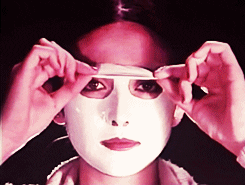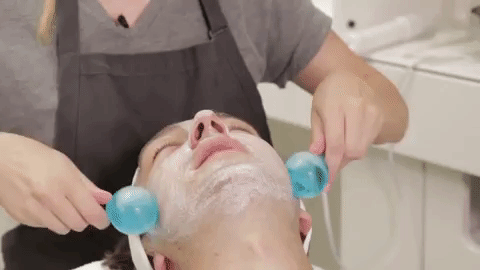Having an exfoliation routine can either make or mar your skin. It could make the difference between smooth, texture free skin and a rough-looking one. But did you know that going about exfoliating the wrong way can be damaging to your skin?
You probably think that there isn’t any science to exfoliating your face, and all you have to do is lather your face with your exfoliant, make some circular motions, and you’re done. But do you know that going about it wrongly can cause significant damage? So before we go into the topic of discussion, how to exfoliate your face proper, let’s touch on skin types.
Skin Types
Normal skin
Skincare experts love this skin type and commonly refer to it as well balanced skin. It’s indeed well balanced, as it is neither too dry nor oily. Instead, it produces sebum in just the right amount, and because of this, it’s less prone to acne.
Dry skin
Dry skin produces less sebum than normal skin. It is characterized by rough texture, skin tightness after your facial Cleansing routine and sometimes, dull colour.
Oily skin
This skin type produces more sebum than normal skin, and it always has a shine to it. As a result, people with oily skin are more prone to acne and have enlarged pores.
Sensitive skin
You ought to be careful of what you put and do to your face/skin with this skin type. This is because you’re prone to irritation and reactions, which usually come in redness, acne and burning.
Combination skin
This is a mixture of oily and dry skin. Usually, the t-zone, which consists of your forehead, nose, chin, and area below your mouth, tends to be oily while your cheeks dry.
What to Exfoliate your Face with

To exfoliate your face, you need an exfoliant. Generally, they’re two types of exfoliants: physical exfoliants and chemical exfoliants.
Physical Exfoliants
An excellent example of this is your face scrub. You know the one with tiny granules in them. With physical exfoliation, what you do is use friction to remove dead skin cells from your face. Suppose you’re going to choose this manner of exfoliation.
In that case, you do have to consider the thickness and sensitivity of your skin, along with the size of the particles/granules in your exfoliant.
You could decide to make your DIY scrub or buy from a trusted skincare brand. Either way, they’re sure things to consider before choosing your exfoliating scrub.
Large particles/granules
Under this category are sugar used in your DIY facial scrub and magnesium oxide crystals which are sometimes used in microdermabrasion procedures.
I think only people with super oily skin should go large particles in their exfoliant. This is because these large particles are more abrasive, and since more oily skin has larger sebaceous glands, they can tolerate them with no damage.
Small particles/granules
These particles include jojoba beads and ruby crystals. They’re usually small, uniform in shape, and are less likely to cause minor skin tears, reactions, or irritation. If you have sensitive and dry skin, look towards scrubs that contain these tiny particles.
Seeds and crushed nutshells
These are a lot more popular than scrubs with large or small particles. However, natural or organic doesn’t always mean better, and not all skin types benefit from scrubs with seeds or nutshells? Also, you want to steer clear of them if you have sensitive skin as they’re not always uniform in size and could give you minor tears and cuts.
Mechanical Exfoliants
Closely related to physical exfoliation is mechanical exfoliation. Here, you use specific tools that aid the removal of dead skin cells. These tools include:
Exfoliating brush
This involves using a facial brush on the face to get rid of the dead skin cells. To use, apply some drops of your face wash to it and brush your face in circular motions. If you got sensitive skin, do not use it twice weekly and always use a light hand.
Exfoliating gloves
If brushes are too hard on your skin, then consider using exfoliating gloves. They are specially designed to remove dead skin cells while paving the way for healthier, brighter skin.
Like facial brushes, apply a drop or two of your face wash and work it into your face in soft, circular motions. This is best if you want a soft and gentle way of getting rid of the dead skin cells on your face. They’re great for whole-body exfoliation too.
Chemical Exfoliants

Chemical exfoliants work by breaking down the tissue that holds dead skin cells together, promoting exfoliation and revealing healthier, smoother skin.
Skincare experts recommend this exfoliation type for oily and sensitive skin. They help your acne-prone skin and are highly tolerable, so you don’t have to worry about irritation or damage unless you have susceptible skin.
Hydroxy Acids
Hydroxy acids are the most common way to exfoliate your skin chemically. They smoothen, tighten, brighten and firm up your skin through the promotion of new skin cells.
One good thing about these acids is that almost everyone can tolerate them in low concentrations and over-the-counter products. Hydroxy acids come in two main types; Alpha Hydroxy acids (AHA) and Beta Hydroxy acids (BHA). They’re gotten from food (sugarcane, milk) and plant-based sources (Willow bark).
These acids work in similar ways while producing slightly different results. While AHA dissolves in water, BHA dissolves in oil, making them a holy grail for oily skin.
AHA
The common types of AHA are glycolic acid, lactic acid, and mandelic acid.
Glycolic Acids
Beauty experts consider this acid to be the best performing AHA as it’s able to penetrate your skin very deeply and fast. Derived from sugarcane, this acid, while exfoliating your skin, will stimulate collagen production, reduce the appearance of wrinkles and will reduce photodamage.
You’ll benefit from this acid if you have mature skin or dry skin. This is because it draws moisture into your skin, prevents water loss, and increases the levels of hyaluronic acid in your skin.
While it penetrates your skin deeply and fast, you should know that because of this, you’re more likely to develop irritation. So if your skin is sensitive, avoid this acid.
Lactic Acid
As the name suggests, it’s most commonly derived from sour milk. Like glycolic acid, lactic acid works by increasing the moisture level in the topmost layer of the skin; it improves your skin’s barrier function, reduces dryness, and gets rid of dead skin cells.
Skincare junkies also love lactic acid for increasing skin thickness and brighten sunspots.
Because lactic acid does not penetrate the skin as deeply as glycolic acid, you’ll benefit from it if your skin is sensitive.
Mandelic Acid
Often referred to as the multitasking acid, mandelic acid is derived from bitter almonds and wild cherry. This highly versatile acid helps to reduce fine lines, firm up the skin, reduce acne and apparent hyperpigmentation.
If you’re dark-skinned or have sensitive skin, you’ll benefit from using this acid. Also, if you’re prone to acne, you might want to consider this acid as it’s highly effective against clearing out clogged pores.
BHA
Salicylic acid is the most popularly used BHA.
Salicylic Acid
This acid is derived from Willow bark and can be considered the most commonly used hydroxy acid. Salicylic acid is highly effective at dissolving dead skin cells on the surface of your skin while also clearing excess sebum and gunk that lead to acne.
It’s also great at removing dark spots without irritating your skin because of its anti-inflammatory properties.
Dark-skinned people and people with acne-prone oily skin will benefit from this acid. If you have hyperpigmentation issues, salicylic acid does a fantastic job at skin brightening. It works astonishing well on age and sunspots too.
One reason why salicylic acid is so commonly used in skincare products is its predictability. Generally, it’s considered safe and less drying to the skin if used properly. However, you want to pair this acid with an antibacterial product for the best results for those with acne-prone skin.
The recommended concentration for this acid is 0.5 to 2%.
How to Exfoliate Your Face

To eliminate dead skins on your face while employing a physical exfoliant, you should begin with washing your face with your regular cleanser. Then, like a prescription given to you by your doctor, use the required dosage or quantity of face scrub and apply it on your face in a circular motion whilst avoiding your eyes.
Leave the exfoliant on the skin for as long as the instructions say. Sometimes, it’s a minute; sometimes, it’s less. After this, rinse off with lukewarm water and gently pat your face dry with a clean towel. Then, follow suit with your hydrating mask, serum or moisturizer.
If you decide a chemical exfoliant is your cup of tea, you should, first of all, cleanse your face before applying your exfoliant. Then, if you desire, you can use it on your neck too.
Usually, you’re required to leave it only for a few minutes; ensure you follow the instructions on your product. Your chemical exfoliant could be in the form of gel, cream, serums, but the application is the same, rub in a circular, soft motion.
How Often should you Exfoliate your Face?
Ideally, you should exfoliate your skin one to two times weekly, mainly if you use a physical or mechanical exfoliant and have oily skin. However, these exfoliants tend to be abrasive on the skin, so using them more than three times weekly can be damaging.
On the other hand, chemical exfoliants are more gentle on the skin and are safe to use more often. Three times weekly is standard.
People with dry or sensitive skin need to be careful with exfoliants. I would recommend they do it once weekly and with a chemical exfoliant. Ensure you moisturize your skin immediately after.
Benefits of Exfoliating your skin
- Remove Dead Skin Cells: To Exfoliate means to remove dead cells resulting in brighter, smoother and healthier skin.
- Improves Blood Circulation: This is because the skin opens up, blood flows better.
- Improved Skin Condition: Your skincare products work better by getting rid of dead skin cells on your face, and you get to see actual results. You get younger-looking skin and that glow we all crave.
These benefits are too good to miss out on, so exfoliate your face the proper way!
